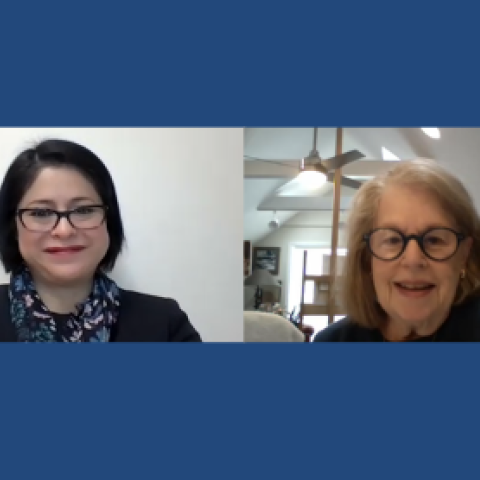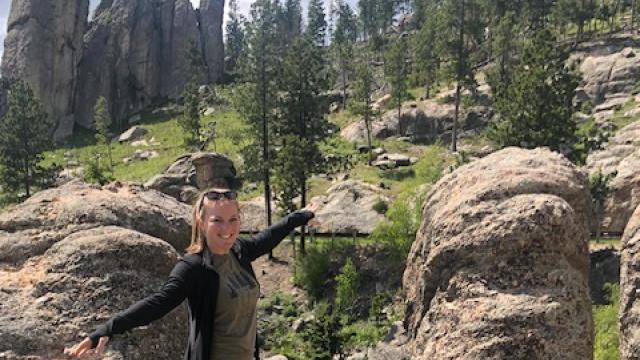
Dr. Del Rivero talks with trial participant Nan Fuhrman about her experience living with neuroendocrine tumors.
Photo Credit: John Arnst
Jaydira Del Rivero, M.D., Assistant Research Physician in the Developmental Therapeutics Branch, studies neuroendocrine tumors – a rare group of malignant neoplasms that originate from neuroendocrine cells, affect almost any part of the body and make up less than one percent of cancer cases in the United States. As the principal investigator for the Natural History Study of Children and Adults with Neuroendocrine Neoplasms (NENs), Dr. Del Rivero’s current efforts include the development of novel treatment approaches and targeted therapies for endocrine malignancies, such as advanced neuroendocrine tumors.
In this Q&A, Dr. Del Rivero and Nan Fuhrman, a participant in the natural history study and an advocate for survivors of neuroendocrine tumors, discuss the study and the need to increase awareness of these tumors.
What is a natural history study, and why is this study of NENs important?
JDR: A natural history study is a comprehensive, longitudinal study where we observe patients with cancer over time to learn more about their disease. We collect medical records and use questionnaires to gather the family and medical history of each patient. We also put together any imaging, surgical pathology and molecular analysis that was done throughout the course of the disease. With this information, we give recommendations and guidance about treatment options.
This type of study also establishes a more formal mechanism for patient referrals and at the same time collects all clinical data and much-needed tumor samples. Pre-clinical models are severely limited, which makes drug development quite challenging. We’re hoping that this particular study, which we began enrolling patients for in early 2019, will allow us to classify neuroendocrine tumors comprehensively in order to provide more guidance in how we treat and manage them. It will also allow us to obtain information to develop more effective therapies for such tumors.
Nan Fuhrman, how did you learn about and join this NENs natural history study?
NF: I have neuroendocrine tumors (NETs), originally discovered in my small intestine in 2008 through surgery. After finding a tumor in my small intestine during surgery in 2011, my doctors started me on a medication that stops my body from making too many hormones to reduce the tumors’ growth and symptoms. But in 2017, my doctors saw more tumor growth, mostly in my liver. Around that time, I had heard about Dr. Del Rivero through a friend of a friend who worked at NIH. On talking with the doctors at NIH, I decided to try their approach to treat my NETs.
In 2018, over a nine-month period, the doctors at NIH destroyed some of the larger liver tumors that had developed. Those procedures helped me a lot. But then, we noticed more growth in the liver, and Dr. Del Rivero suggested that I do Peptide Receptor Radionuclide Therapy (PRRT), which is a treatment administered through a vein in the arm that only targets neuroendocrine cells and tumors. The NIH was not offering PRRT in 2021, so I received the treatment at two other hospitals. Now, I’m feeling much better, so I’m hoping that upcoming scans will show, at a minimum, tumor control.
This disease doesn’t go away, and I will live with it until I die. But there is always hope that there’s a new treatment, and that’s what NIH provides – that opportunity. And receiving treatment at the NIH is a huge advantage. I know I can get all my bloodwork, all my scans and much of my treatment in one place, and at no cost.
Dr. Del Rivero, Is that a typical treatment sequence?
JDR: The clinical management of all neuroendocrine tumors can be quite complex and not standardized, with only a few Food and Drug Administration-approved therapies available. It’s not like “one-size-fits-all,” compared to other cancers where there are first-, second- and third-line treatments that are well-delineated in standardized guidelines.
For neuroendocrine tumors, when and which combination therapeutic approach should be used, how long treatment should be continued and in what subgroup of patients a particular treatment option should be used is currently unclear. Moreover, a multidisciplinary team of medical oncologists, surgeons, gastroenterologists, pathologists, radiation oncologists, nuclear medicine specialists and endocrinologists have to thoroughly discuss a patient to then provide that person with the best advice and guidance.
In this kind of natural history study, what role do you feel the doctor-patient relationship plays and has played?
JDR: By having this study, we better understand what the patient’s needs are. Patients play a crucial role in determining what is best for them and how we can help them, and physicians and researchers need to be more involved with them. I think that’s very important if we want to advance the science.
I’m very fortunate to be in a place like NIH that understands the importance of research and its ability to enhance the quality of life of patients through natural history studies and through treatment studies. Ten years ago, we didn’t have that many options for neuroendocrine tumors. Now, we have some, but there is still a lot of room for improvement.
I’m hoping that through working with advocacy groups, patients, researchers and physicians, we will be able to develop better therapies for neuroendocrine tumors. It takes a village, that’s the reality, and that village includes patients. And I’m just very fortunate and blessed to work with patients like Mrs. Fuhrman.
NF: I’d like to really highlight the importance of communicating with doctors. We emphasize at every support group meeting that patients need a team, and they need to have a neuroendocrine tumor specialist on their team.
Nan Fuhrman is active with the Capital Area Carcinoid Cancer/Neuroendocrine Tumor Survivors’ support group, or CACNETS. CACNETS is a patient-led support group whose mission is to allow patients and caregivers to share their experiences with NETs and to increase awareness of NET. They bring in specialists, including Dr. Del Rivero, from across the country to meet and inform members about the disease. Dr. Del Rivero updates them on research advances she learns of from NANETS, the North American Neuroendocrine Tumor Society, and ENETS, the European Neuroendocrine Tumor Society and other NET experts and colleagues. “We value that input tremendously,” Fuhrman says. “It keeps us all informed and able to think about the decisions we need to make about our treatment options, as well as to know that we do have futures.”
Find more information below about the trial mentioned in this interview, as well as information about another trial that Dr. Del Rivero is co-chairing:
Clinicaltrials.gov identifier: NCT04488263
NCI Protocol ID: NCI-20-C-0139
Official Title: Natural History Study of Children and Adults With Neuroendocrine Neoplasms (NENs)
Clinicaltrials.gov identifier: NCT04394858
Official Title: A Prospective, Multi-Institutional Phase II Trial Evaluating Temozolomide vs. Temozolomide and Olaparib for Advanced Pheochromocytoma and Paraganglioma
The Center for Cancer Research is NCI’s internal cancer center, a publicly funded organization working to improve the lives of cancer patients by solving important, challenging and neglected problems in cancer research and patient care. Highly trained physician-scientists develop and carry out clinical trials to create the medicines of tomorrow treating patients at the world’s largest dedicated research hospital on the campus of the National Institutes of Health in Bethesda, Maryland.
For more information on CCR clinical trials click here, and subscribe to have the latest CCR clinical trials sent directly to your inbox.


